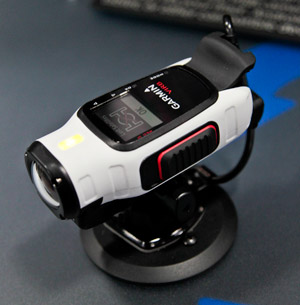 Garmin has jumped into the action-camera market with the VIRB, a compact, well-engineered unit that’s sure to log lots of flight time in general aviation aircraft. Garmin takes on market-leader GoPro with features its dominant rival lacks: a battery that lasts up to three hours and an included viewfinder. Since the VIRB isn’t stored in a protective housing, it’s likely to be far less susceptible to the fogging that can come from rapid altitude and temperature changes in flight.
Garmin has jumped into the action-camera market with the VIRB, a compact, well-engineered unit that’s sure to log lots of flight time in general aviation aircraft. Garmin takes on market-leader GoPro with features its dominant rival lacks: a battery that lasts up to three hours and an included viewfinder. Since the VIRB isn’t stored in a protective housing, it’s likely to be far less susceptible to the fogging that can come from rapid altitude and temperature changes in flight.
An aviation-specific VIRB is scheduled for release in early 2014, and it will have a neutral-density filter to reduce propeller distortion and headset plug-ins to record cockpit audio. (Those modifications can be retrofit to existing VIRBs.)
On my first flight with the VIRB, I attached it to the wing tip of an RV–4 and gave the camera and its mount a 200-mph workout. The mount was rock solid, and the image quality (1080P) excellent.
The VIRB resembles a Drift—one of the early entrants into the action-cam game that has been eclipsed by the GoPro phenomenon. The VIRB fits neatly in the palm of one hand. It’s substantial and made from durable components, and it will seem familiar to users of other Garmin aviation and outdoor products. Details such as the battery door have the same locking mechanism as the company’s aviation GPS portables, and the rubber port protectors are identical, too. The exterior is reminiscent of Garmin’s popular eTrex.
The VIRB’s color viewfinder is a nice addition that allows users to line up their shots before recording, and to play back video in the field. Both avoid those screaming, furniture-kicking moments when one realizes he improperly aligned the camera, or failed to start it. (Been there, done that.)
On recording, the VIRB is nearly foolproof. Even if you forget to turn the unit on, simply sliding the “record” bar forward starts the camera and a bright-red LED indicates that it’s working. The viewfinder shows what the camera lens is seeing, and text at the bottom of the screen tells how much recording time is available.
The VIRB also makes fine still photos of up to 16 megapixels.
The VIRB comes with a light, rugged, and adaptable mount that is one of the camera’s finest features. It can be placed virtually anywhere in an aircraft cockpit, or on the exterior of the airframe (with proper approvals and precautions, of course).
The VIRB is waterproof and can be safely submerged in three feet of water, but aviation presents special demands in this area. Precipitation encountered at triple-digit speeds can force moisture into some way-out-of-the-way places, so I’ll be curious to find out how the VIRB holds up in rain.
The VIRB has two USB ports with standard mini and micro connections, so thank you, Garmin, for not forcing us to buy yet another wire for the privilege of plugging in. The USB ports are used for downloading video to a laptop computer, and charging the camera’s lithium-ion battery.
For pilots, Garmin’s move into sports cameras seems like a stretch. We know the company for its avionics. But Garmin is a major player in hiking, biking, exercise, and boating GPS equipment and the VIRB fits neatly with those offerings. In fact, the VIRB Elite can be connected to a Garmin heart monitor and show a runner, for example, how hard his or her heart is working at any particular stage of a workout or a race. The VIRB Elite also has a “ski” setting that senses when it’s going downhill and automatically starts recording.
I’d be surprised if pilots were interested in such biometrics, or wanted to automatically record descents and landings, but you never know. Garmin officials say aerobatic pilots will want to know their heart rates and find out how strenuous their maneuvers are, and many pilots are active people who will want to engage their VIRBs in other pursuits.
The VIRB Elite can be manipulated via Wi-Fi using Garmin’s new D2 wristwatch as well as a smartphone app. The regular VIRB cannot. All VIRBs have built-in GPS, and GPS data can be downloaded using free Garmin software.
I like the VIRB’s form factor, ease of use, viewfinder, and mount. The fact that VIRB videos don’t all begin and end with the camera operator’s squinty face that GoPro users know so well is an added bonus. Also, it would be nice if the VIRB came with a lens cover or something to prevent the glass from being scratched. And the customized aviation features can’t come soon enough for me.
Garmin’s VIRB is likely to win a significant slice of the burgeoning market for action-cams, especially among pilots, boaters, and triathletes who already know and trust the Kansas company’s many innovative products.
At a price of $300 to $400, the VIRB isn’t a GoPro killer. Hardcore GoPro fans who demand virtually indestructible cameras and have taken the time to learn their platform’s idiosyncrasies aren’t going to give them up easily. But the VIRB is going to be a popular aviation companion—and switching the camera on is likely to become a normal part of our preflight rituals.
Email [email protected]



